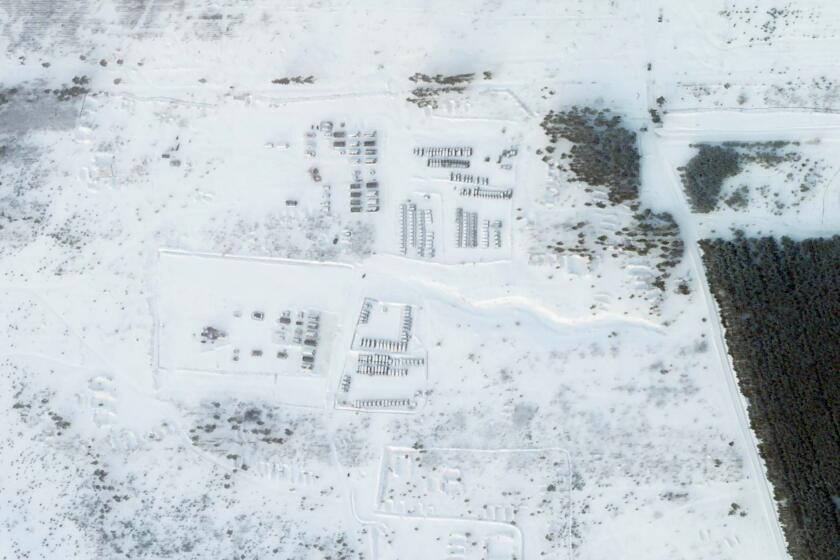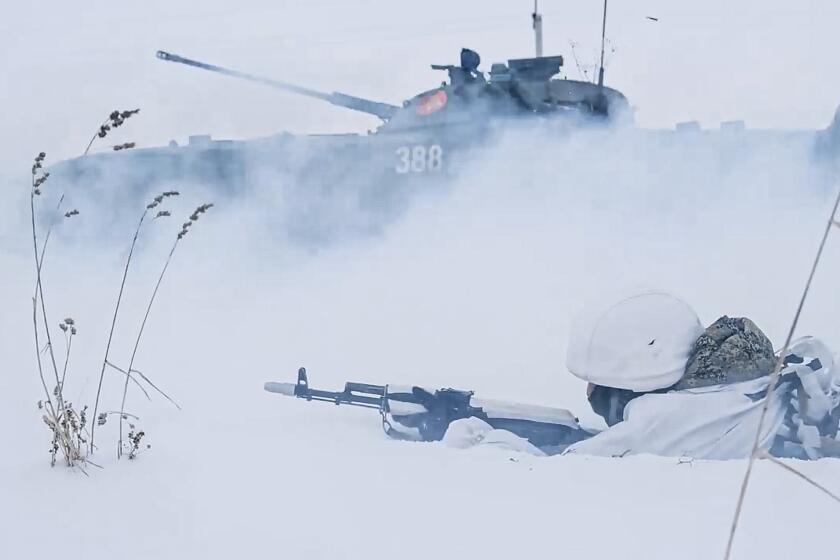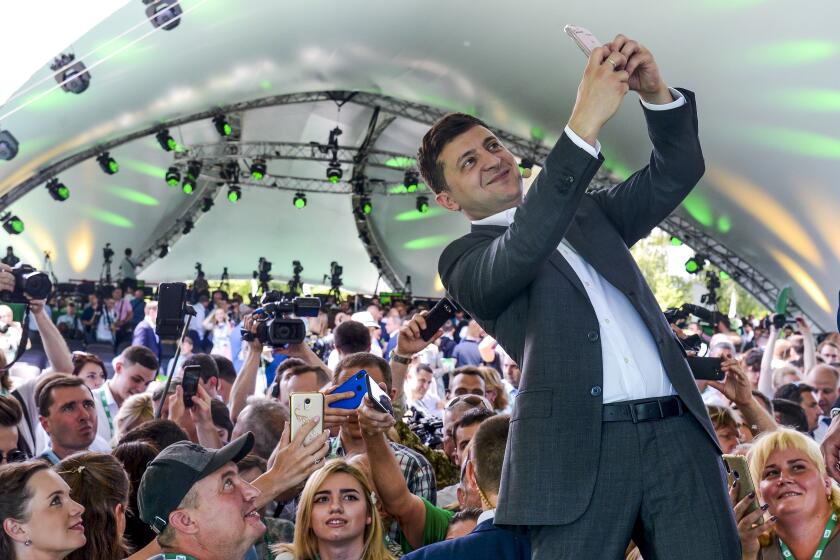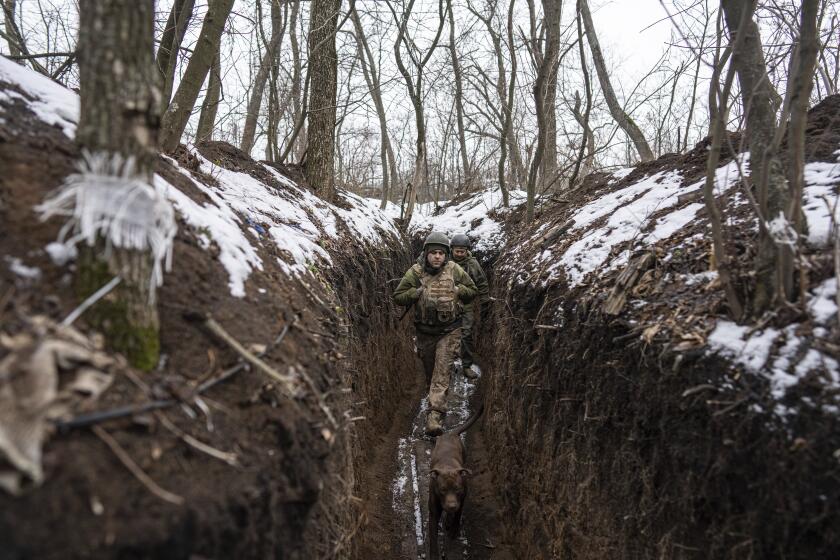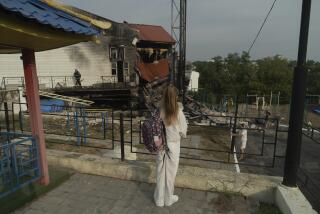Russian disinformation kicks into high gear as Ukraine crisis drags on
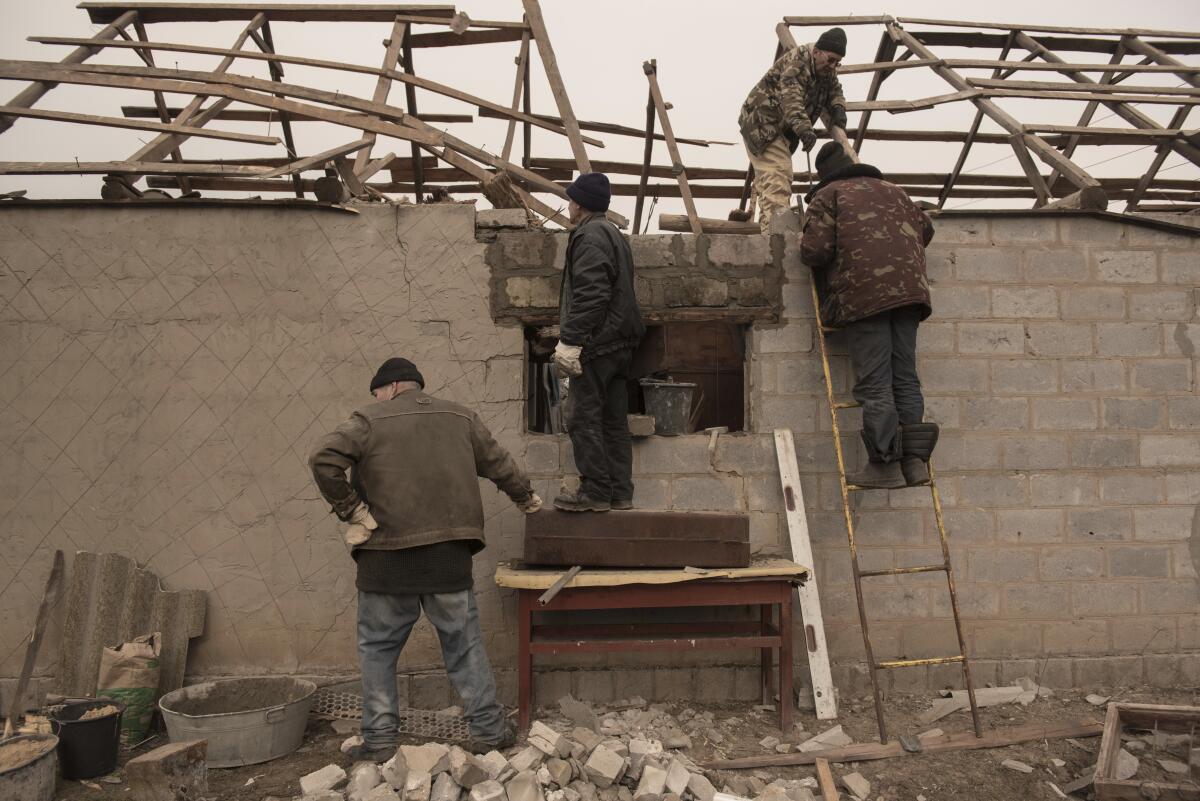
- Share via
KYIV, Ukraine — To hear Russian media tell it, the government of Ukraine is run by neo-Nazis waging a genocidal campaign against ethnic Russians in the country’s east, where Moscow-backed authorities regularly uncover mass graves full of the corpses of women and children with bound hands and bludgeoned heads even as they face the hell of constant shelling.
Such false images and narratives have become a daily staple in Russia in the months since an estimated 150,000 Russian troops, along with armored vehicles, warplanes and naval ships, began assembling on Ukraine’s periphery. The Russian media have gone into overdrive with stories depicting a government in Kyiv so cruel that Moscow has no choice but to swoop in and protect the ethnic Russians in eastern Ukraine’s Donbas region.
“It’s a war between the Ukrainian government and its own people. ... People are dying there every day. Thousands of civilians died there. Thousands of children lost their limbs there, buried in little coffins,” Margarita Simonyan, head of the state-funded broadcaster RT, said on a talk show on the Russia-1 channel.
“Go there once. ... You’ll change your attitude completely. And you’ll understand that Russia can’t help but stop this war. Do we have to wait until they organize concentration camps out there? Until they start poisoning their people with gas?”
Russian officials, including President Vladimir Putin, have reinforced such views. At a news conference with German Chancellor Olaf Scholz this week, Putin said that “in our view, what is now happening in Donbas is genocide,” even as he insisted that he would pursue diplomacy to resolve the situation in Donetsk and Luhansk, the two enclaves that make up Donbas.
Fighting between Ukrainian forces and Russia-backed separatists has raged in the region since 2014 and killed more than 14,000 people. A tenuous cease-fire has been in place for about seven years, but both sides regularly accuse each other of violations.
Further amplifying the Russian rhetoric is a veritable army of Moscow-aligned digital activists and social media accounts. Their fabricated stories have added to the skyrocketing number of online posts on the crisis in Ukraine, which has almost tripled in recent weeks, said Joe Ondrak, head of investigations at Logically, a London-based firm that tracks disinformation.
The Biden administration and its allies are taking a proactive approach to publicizing intelligence findings as they raise alarms about a possible new Russian invasion of Ukraine.
“What in December was around 7,000 to 8,000 posts a day is now more than 20,000,” he said.
Over the last year and a half, Logically has tracked certain narratives that get wheeled out at different times to achieve a desired effect. One “tried and tested cudgel” by Russia-aligned disinformation groups, Ondrak said, is the portrayal of Ukraine as a country full of neo-Nazis — a trope employed last month and again this week.
On Twitter and the instant-messaging app Telegram, accounts in the last two or three days took gruesome images of Syria’s brutal civil war and misrepresented them as photos from Donbas and other areas of Ukraine.
“It’s this idea that this is all against the Russians’ will, casting them as being put upon and setting a pretext for them to defend the Russian-backed separatists,” Ondrak said.
U.S. says Russia developed a plan to stage a false attack to help establish a pretext for military action against Ukraine.
U.S. officials have responded. On Wednesday, the U.S. mission to the Organization for Security and Cooperation in Europe, or OSCE, which monitors the situation in eastern Ukraine, rebuked Russia’s claims of genocide in Donbas as a “reprehensible falsehood.”
OSCE’s special monitoring mission “has complete access to the government controlled areas of Ukraine and HAS NEVER reported anything remotely resembling Russia’s claims,” said a tweet on the social media account of the U.S. mission.
Also on Wednesday, a senior Biden administration official, who spoke on condition of anonymity, accused Moscow of trotting out a bevy of false claims with the intention of using them as a casus belli for an incursion into Ukraine. Those claims included reports of unmarked graves of civilians killed by Ukrainian armed forces in the east, statements that the U.S. and Ukraine are developing biological or chemical weapons, and warnings that the West is bringing in guerrillas to kill locals.
“Each of these allegations is categorically false, and we should expect more false reports from Russian state media over the coming days,” the official said, adding that Moscow had used this playbook to justify previous incursions into Ukraine.
Some Ukrainians are starting to wonder whether their neophyte leader has the smarts and strength to lead them through a moment of peril.
Thursday began with fears that an anticipated “false flag” attack had materialized when the Russian state news agency RIA Novosti said that Ukrainian forces had violated a cease-fire in Donbas and shelled a kindergarten in Stanytsia Luhanska, a settlement near the front line. Pro-Russia journalists and activists claimed it was part of a large-scale bombardment by Ukrainian forces of areas controlled by the separatists.
But observers noted soon afterward that the kindergarten was on the Ukrainian-controlled side of the front line. The Ukrainian Defense Ministry said the attack was one of 29 cease-fire violations by the separatists, with the kindergarten and its environs struck by 32 artillery shells.
“The shelling of a kindergarten in Stanytsia Luhanska by pro-Russian forces is a big provocation,” Ukrainian President Volodymyr Zelensky said on Twitter. “We need an effective mechanism for recording all cease-fire violations.”
Asked about the shelling in a news conference at North Atlantic Treaty Organization headquarters in Brussels, U.S. Defense Secretary Lloyd J. Austin III said: “We’ve said for some time that the Russians might do something like this in order to justify a military conflict. So we’ll be watching this very closely.”
Pictures posted on social media depicted a hole blown through a brick wall, with chunks of masonry scattered on a floor along with a number of soccer balls in what appeared to be a playroom. Reports said three adults were injured.
Russia blamed the attack on Ukraine.
“We have repeatedly warned that Ukraine’s excessive military buildup in close proximity to the line of contact, along with possible provocations, could pose a great danger,” Kremlin spokesman Dmitry Peskov told reporters, adding that “the situation near the borders of Russia can ignite at any moment.”
He described the incident as an exchange of strikes on the line of contact, but said that “the first strikes came from Ukraine.”
With Russian troops just miles away, the residents of a small Ukrainian village wonder if a possible invasion has its sights set on them.
“This is very alarming information,” he said.
Though a large amount of Moscow’s messaging is aimed at audiences at home, some of the propaganda has been designed to appeal to and be amplified by various left-wing and social groups in the West, Ondrak said.
“One of the things we’ve noticed in the past month is a trial run to see where they can foster a sympathetic ear in Western audiences, and hitting hard on NATO expansions, framing it as American imperialism by another name,” he said.
Another target of Russian disinformation is Ukraine. This month, the Security Service of Ukraine announced that it had uncovered and shut down a pair of so-called bot farms controlling 18,000 accounts that were sowing panic on social media and sending out bomb threats. The security service said in a statement that preliminary investigations indicated they had been set up by Russian parties.
Breaking News
Get breaking news, investigations, analysis and more signature journalism from the Los Angeles Times in your inbox.
You may occasionally receive promotional content from the Los Angeles Times.
Perhaps the most damaging piece of disinformation in recent days, said Lada Roslycky of the Ukraine-focused security consultancy Black Trident, was the rumor, supposedly based on intelligence, that Russia would launch an assault on Ukraine on Wednesday. Zelensky, the Ukrainian president, even repeated the rumor publicly, as did media reports whose combined effect wreaked havoc on the Ukrainian economy as well as on residents’ state of mind, Roslycky said.
“People in Kyiv were really upset waiting for things to happen on the 16th, and now we’re waiting for the next date,” she said. “These leaks lead to nothing except psychological harm.”
The false information and fearful reaction gave Moscow another reason to crow — and to paint all Western talk of invasion as ridiculous. On Thursday, President Biden continued to insist that a Russian attack could come at any time, and another rumor apparently surfaced that an assault was planned for sometime after Sunday.
“It looks like another fake has been coined,” Peskov, the Kremlin spokesman, said, according to Russian news agency Tass.
“There have been many dates, and far more specific ones,” Peskov added. “Honestly, I don’t know about their audience, but our audience, at least, simply laughs at it.”
More to Read
Sign up for Essential California
The most important California stories and recommendations in your inbox every morning.
You may occasionally receive promotional content from the Los Angeles Times.
